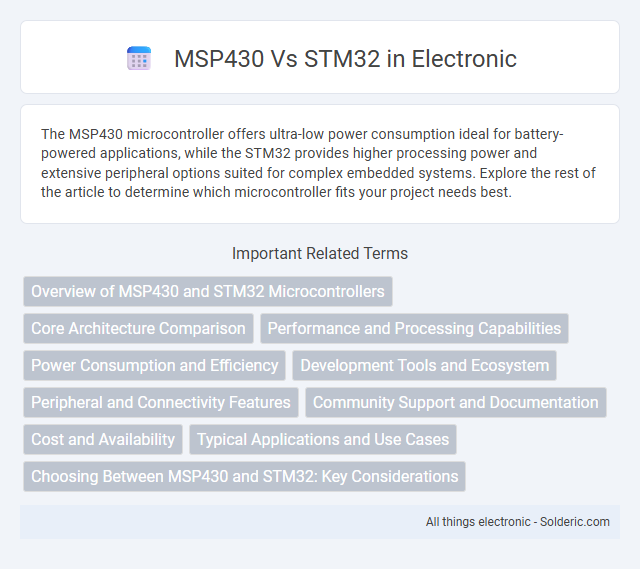The MSP430 microcontroller offers ultra-low power consumption ideal for battery-powered applications, while the STM32 provides higher processing power and extensive peripheral options suited for complex embedded systems. Explore the rest of the article to determine which microcontroller fits your project needs best.
Comparison Table
| Feature | MSP430 | STM32 |
|---|---|---|
| Manufacturer | Texas Instruments | STMicroelectronics |
| Core Architecture | 16-bit RISC | 32-bit ARM Cortex-M |
| Operating Frequency | up to 25 MHz | up to 480 MHz |
| Power Consumption | Ultra-low power | Low to ultra-low power |
| Flash Memory | up to 512 KB | up to 2 MB |
| RAM | up to 66 KB | up to 640 KB |
| Peripherals | Basic timers, ADC, UART, SPI, I2C | Advanced timers, multiple ADCs, DAC, USB, CAN, Ethernet |
| Development Environment | Code Composer Studio, IAR Embedded Workbench | STM32CubeIDE, Keil MDK, IAR Embedded Workbench |
| Use Cases | Low power, simple applications, battery-powered devices | Complex applications, real-time control, IoT, multimedia |
| Price Range | Low to moderate | Moderate to high |
Overview of MSP430 and STM32 Microcontrollers
The MSP430 microcontroller, developed by Texas Instruments, is a low-power 16-bit MCU designed for energy-efficient applications such as wearable devices and sensor systems. STM32, created by STMicroelectronics, is a 32-bit ARM Cortex-M series MCU family offering higher processing power, extensive peripheral options, and broad scalability for industrial, automotive, and IoT applications. Both platforms provide robust development ecosystems but cater to distinct performance and power consumption requirements.
Core Architecture Comparison
The MSP430 microcontroller utilizes a 16-bit RISC core designed for ultra-low power consumption, making it ideal for battery-operated applications. In contrast, the STM32 series is based on 32-bit ARM Cortex cores, offering higher processing power and extensive peripheral integration for complex embedded systems. Your choice between MSP430's efficiency and STM32's performance depends on the specific application requirements and power constraints.
Performance and Processing Capabilities
STM32 microcontrollers typically offer higher clock speeds, ranging from 32 MHz to over 400 MHz, compared to MSP430's maximum of around 25 MHz, resulting in superior processing power for complex applications. STM32 series feature ARM Cortex-M cores with enhanced instruction sets and floating-point units that vastly improve computational efficiency and real-time processing capabilities. MSP430 excels in ultra-low-power consumption and simpler architecture, making it ideal for energy-sensitive designs but less capable in handling intensive computing tasks compared to STM32.
Power Consumption and Efficiency
The MSP430 microcontroller excels in ultra-low power consumption, often operating in sub-microampere modes with efficient power management features ideal for battery-powered applications. In contrast, the STM32 series provides a broader range of power modes, balancing higher processing performance with moderate power efficiency, making it suitable for more complex, energy-conscious embedded systems. Both platforms incorporate advanced power-saving techniques, but the MSP430 consistently outperforms in applications demanding minimal energy use over extended periods.
Development Tools and Ecosystem
MSP430 development relies heavily on TI's Code Composer Studio (CCS), offering integrated debugging and energy profiling specifically tailored for low-power applications. STM32 benefits from a vast ecosystem including STM32CubeIDE, extensive firmware libraries, and support from third-party tools like Keil and IAR, enabling versatile development for varied industrial needs. Both platforms provide rich community support, but STM32's extensive middleware and ecosystem resources accelerate complex application development.
Peripheral and Connectivity Features
The STM32 microcontrollers offer a broad range of peripheral options including advanced communication interfaces such as Ethernet, USB OTG, CAN, and multiple UARTs, SPI, and I2C buses, supporting high-speed connectivity and complex system integration. MSP430 devices provide ultra-low-power peripheral modules optimized for sensor interfacing and simple communication protocols like UART, SPI, and I2C, making them ideal for battery-powered applications. STM32's extensive peripheral diversity surpasses MSP430 in scalability and performance, while MSP430's peripherals emphasize power efficiency and simplicity.
Community Support and Documentation
STM32 microcontrollers benefit from a large, active community and extensive documentation provided by STMicroelectronics, including comprehensive datasheets, application notes, and development tools such as STM32CubeMX. MSP430, produced by Texas Instruments, also has robust documentation and a supportive user base, but its community size and third-party resources are generally smaller compared to STM32. STM32's widespread adoption in diverse applications results in more tutorials, forums, and libraries, enhancing its accessibility for developers.
Cost and Availability
The MSP430 series from Texas Instruments is generally more cost-effective for low-power, simple applications, making it a preferred choice in budget-sensitive projects. STM32 microcontrollers by STMicroelectronics offer a wider range of performance options and are widely available, often leading to competitive pricing for higher-end models. Availability of STM32 components tends to be stronger globally due to extensive distribution networks, whereas MSP430 availability can be more region-specific and limited in high-volume industrial markets.
Typical Applications and Use Cases
MSP430 microcontrollers are typically used in low-power applications such as wearable devices, battery-powered sensors, and simple embedded control systems due to their ultra-low power consumption. STM32 microcontrollers, featuring higher processing power and extensive peripheral options, are preferred for complex applications like industrial automation, motor control, and advanced Internet of Things (IoT) devices. The STM32 family supports real-time operating systems and multimedia capabilities, making it ideal for applications that require high performance and connectivity.
Choosing Between MSP430 and STM32: Key Considerations
Choosing between MSP430 and STM32 hinges on your project's power consumption and processing requirements, with MSP430 excelling in ultra-low power applications and STM32 offering higher performance and richer peripheral sets. STM32 MCUs provide extensive ARM Cortex cores and advanced connectivity options, ideal for complex embedded systems, while MSP430's simple architecture suits energy-efficient designs and cost-sensitive projects. Evaluate your application's need for processing speed, power efficiency, and peripheral integration to determine which microcontroller family aligns best with your development goals.
MSP430 vs STM32 Infographic

 solderic.com
solderic.com